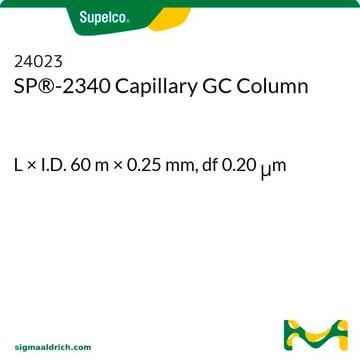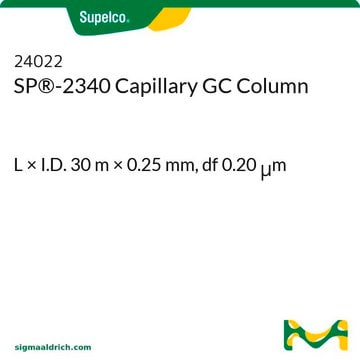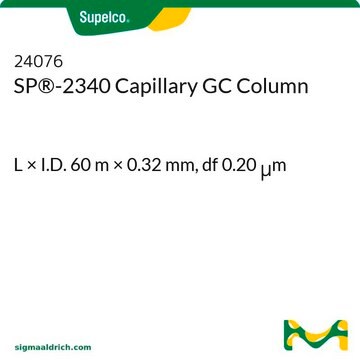24075
SP®-2340 Capillary GC Column
L × I.D. 30 m × 0.32 mm, df 0.20 μm
Sign Into View Organizational & Contract Pricing
All Photos(1)
About This Item
UNSPSC Code:
41115710
eCl@ss:
32119290
Recommended Products
material
fused silica
Agency
meets requirements for USP G5
parameter
≤25-250 °C temperature (isothermal or programmed)
Beta value
400
df
0.20 μm
technique(s)
gas chromatography (GC): suitable
L × I.D.
30 m × 0.32 mm
matrix active group
Non-bonded; poly(biscyanopropyl siloxane) phase
column type
capillary highly polar
Looking for similar products? Visit Product Comparison Guide
General description
SP®-2340 is a cyanopropylsiloxane stationary phase, and has high polarity and temperature resistance.
Application: This non-bonded column offers the highest polarity in its class. As with all general purpose biscyanopropyl columns, it is highly effective for both high and low temperature separations of geometric isomers of fatty acid methyl esters (FAMEs), dioxins, carbohydrates, and aromatic compounds.
USP Code: This column meets USP G5 requirements.
Phase:
USP Code: This column meets USP G5 requirements.
Phase:
- Non-bonded
- Poly(biscyanopropyl siloxane)
- Subambient to 250 °C (isothermal or programmed)
Application
Capillary column coated with SP®-2340 stationary phase may be used in gas chromatographic analysis and separation of cis/trans isomeric fatty acids.
Other Notes
We offer a variety of chromatography accessories including analytical syringes
Legal Information
SP is a registered trademark of Sigma-Aldrich Co. LLC
Choose from one of the most recent versions:
Already Own This Product?
Find documentation for the products that you have recently purchased in the Document Library.
SP 2340 in the glass capillary chromatography of fatty acid methyl esters.
Heckers HF
Journal of Chromatography A, 136 (2), 311-317 (1977)
R H Thompson et al.
Lipids, 16(9), 694-699 (1981-09-01)
Paris of C-24 epimeric sterols have been very difficult to separate by physical emthods. We report here the partial or complete separation of the trimethylsilyl ethers of nine pairs of C-24 epimeric sterols by gas liquid chromatography on a glass
Mikael Harju et al.
Journal of chromatography. A, 1019(1-2), 111-126 (2003-12-03)
Comprehensive two-dimensional gas chromatography (GC x GC) of the 209 polychlorinated biphenyls (CBs) was carried out using a longitudinally modulated cryogenic system (LMCS) and liquid carbon dioxide as cryogen. The effluent from a non-polar column was modulated and further separated
T Iida et al.
Journal of lipid research, 24(2), 211-215 (1983-02-01)
Capillary gas-liquid chromatographic separation was studied for the complete set of the 26 theoretically possible isomers of mono-, di-, and trihydroxylated 5 beta-cholanic acids, which differ from one another in the number, position, and configuration of hydroxyl groups at C-3
H Heckers et al.
The American journal of clinical nutrition, 31(6), 1041-1049 (1978-06-01)
Fatty acid patterns were determined in 83 brands of margarine, 9 brands of low-calorie margarine and 18 brands of shortening, frying and cooking fat purchased at random from the retail marker in the Federal Republic of Germany in 1973/1974, and
Our team of scientists has experience in all areas of research including Life Science, Material Science, Chemical Synthesis, Chromatography, Analytical and many others.
Contact Technical Service







